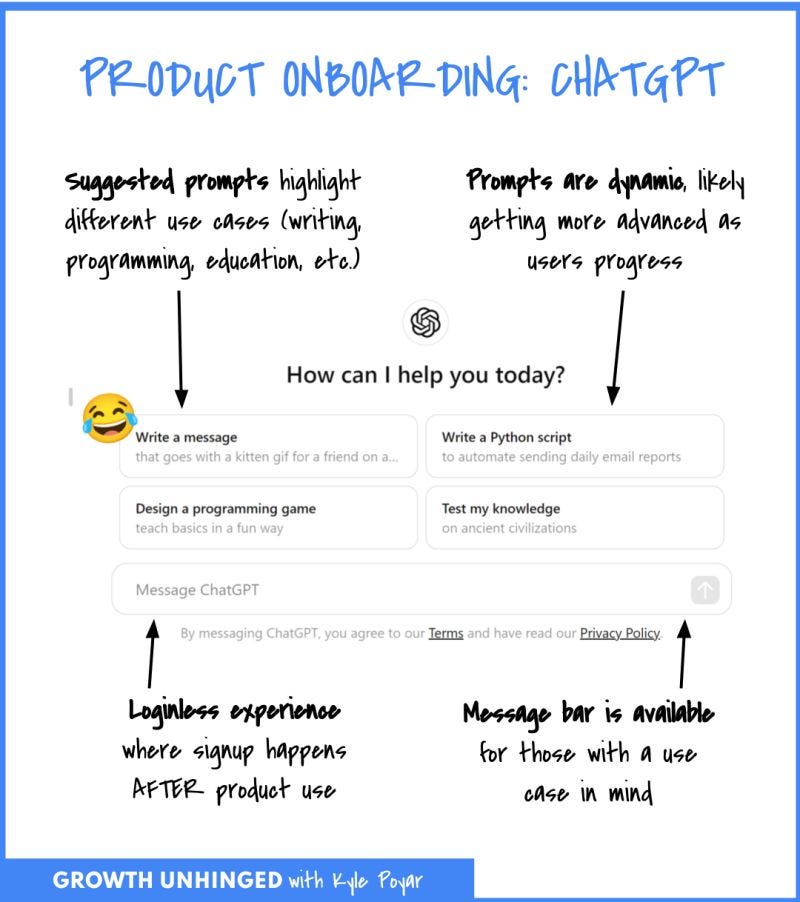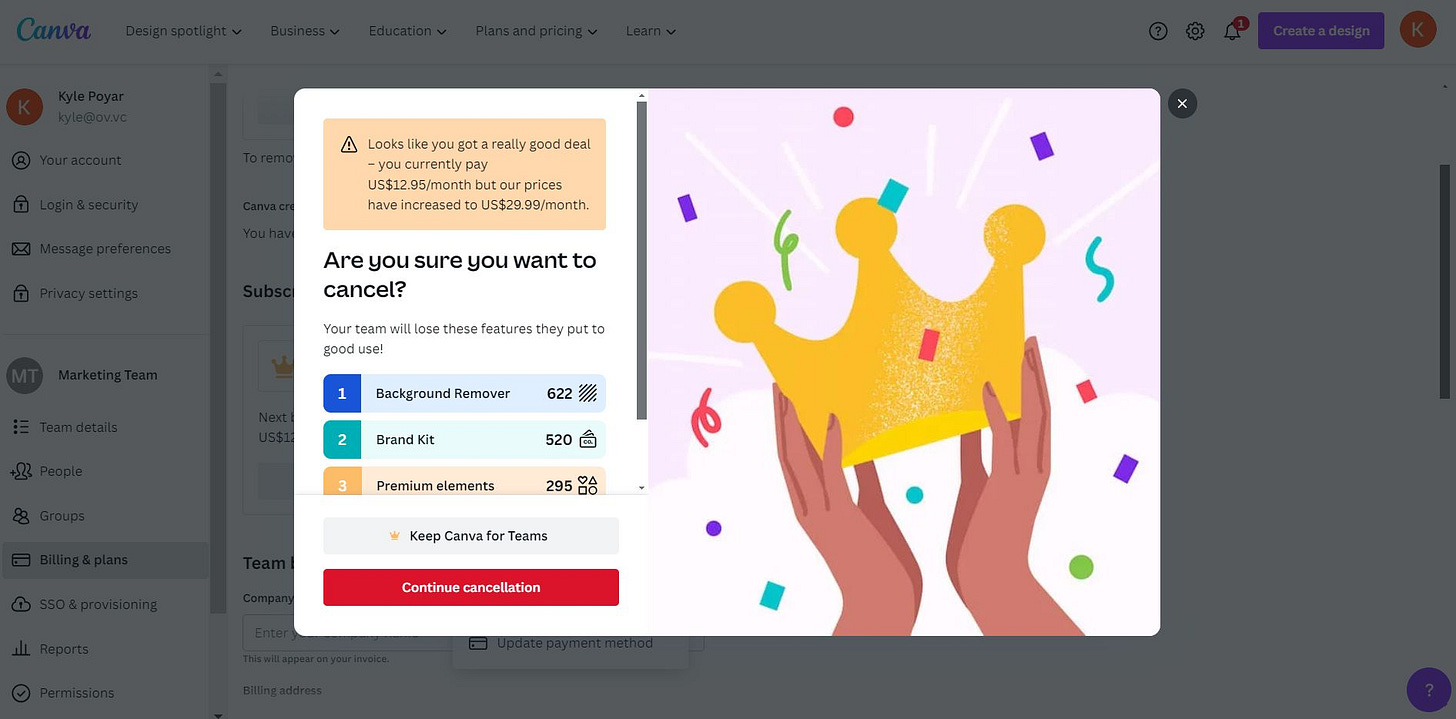Steal these brilliant growth tactics
Breaking down my favorite examples from Canva, Figma, ChatGPT, Perplexity, Miro, Otter, and more
👋 Hi, it’s Kyle and I’m back with a new Growth Unhinged, my newsletter that explores the unexpected behind the fastest-growing startups.
I love to get inspired by what others are doing. It sets aside existing constraints and gets the creative juices flowing, inspiring dreams of what if…
In the last three years I've now signed up for 100+ self-serve products ranging from Asana to Zapier. I wanted to devote today’s Growth Unhinged to exploring the best of the best: my favorite onboarding flow (Miro), cancellation flow (Canva)… even my favorite price increase email (is that an oxymoron?).
I hope these examples inspire your next growth experiment. After you’re done reading, join the conversation on LinkedIn and share your own go-to faves.
Favorite onboarding flow: Miro
Need inspiration for your product onboarding? Look at Miro's approach, it's brilliant.
I come across a number of product onboarding mishaps, especially for those launching a self-serve offering:
🚫 The product is too confusing without sales or success helping out
🚫 There's too much of a blank slate
🚫 It's unclear 'what's in it for me' as a user
🚫 There's no personalization for specific use cases, jobs to be done, or levels of intent
Miro avoids these missteps and has one of my all-time favorite product onboarding experiences. What I'm digging:
😍 Onboarding begins on the website.
Miro has compelling messaging ("take ideas from better to best"). They build trust with social proof ("based on 5,149+ reviews"). Users start building familiarity with the product through product images across desktop, mobile, and presentation-ready devices. All of this gets people inspired and motivated to put in the work.
😍 Nudges folks to sign up with a work email, but doesn't require it.
The disclaimer below the signup button is 🔥: "We recommend using your work email — it keeps work and life separate." This positions Miro as a business-grade product while still offering people flexibility.
Why should you care? Business sign-ups are far more valuable than freemail/Gmail signups, but you may not want to entirely shut off the ability to sign up with a freemail domain (especially if you sell to developers). Some people want to test a product for a personal use case before taking the relationship to the next level.
😍 There's no blank slate.
The app comes pre-populated with recommended Miro boards. These templates include templates sourced from the Miroverse community, adding social proof. Template recommendations are personalized to different use cases.
😍 It's obvious what to do next.
Miro doesn't have excessive in-product tours or pop-ups. The product doesn't need them; the whole experience is extremely intuitive without it.
Bonus: They connect product activity with GTM touchpoints.
Self-service onboarding is the starting point, not the end goal. After our domain reached a critical mass of users, I got the following email from an account rep. It was well-timed, had a compelling subject line (Spike in Miro usage), and had an opinionated perspective about why it would be beneficial to shift from a self-serve to sales-assisted plan. Well done 👏
Favorite ungated product: ChatGPT (& Perplexity)
You can now use ChatGPT instantly without signing up. Honestly, it's not an act of generosity.
After gating the product behind a registration wall since 2022, they pivoted to a more open approach in April 2024. This is part of a broader movement of "ungating" your free product — no email, no login, no problem?
For loginless products, more people try out the product. That means more people get hooked. These engaged users want to save their progress (saved prompts, saved results, sharing templates with their team). And THAT'S when they create an account.
ChatGPT makes for a great example of doing this right. What I'm digging:
😍 They suggest four prompts to easily test out what ChatGPT can do.
Why four? It's enough to show a variety of use cases. But it's not too many to be overwhelming or confusing. Remember the famous jam experiment? Less choice leads to more sales.
😍 Prompts are dynamic, keeping users engaged as they go.
This felt subtle to me. Usually one or two of the prompts would remain in place while the others would get swapped out. Cool experience.
😍 They still offer plenty of customization for advanced users.
Anyone with a use case in mind or who wants to DIY can simply start typing.
But it's not all good, right? Things I wish were different:
😖 There’s no linkage with marketing.
When I clicked into ChatGPT from the "ChatGPT for Teams" landing page, I landed on the same B2C-like experience. There was no reference to sales, marketing, data analysis, etc. use cases. It felt rather jarring as a user.
😖 Alienates B2B or sophisticated use cases.
ChatGPT can be super powerful for teams. But when I see "write a message that goes with a 🐱 gif", it leaves me feeling like I should explore a B2B-oriented tool like Perplexity, Copy.ai, Writer, or Jasper.
😖 No linkage to monetization.
When you land on the ChatGPT website, you almost can't navigate to information about pricing or premium editions.
Compare that to Perplexity — another generative AI productivity tool. Perplexity lets you easily toggle "on" the Pro edition and start a free trial. And they explain why you should upgrade with concise value messaging. It's a pretty 🔥 experience.

Favorite cancellation flow: Canva
I went to cancel my Canva Teams account a few weeks ago. Canva's cancellation flow was so good that I changed my mind (and went unexpectedly viral). And, no, it wasn't because they made me jump through hoops.
Things I loved about Canva’s cancellation flow:
Keep reading with a 7-day free trial
Subscribe to Kyle Poyar’s Growth Unhinged to keep reading this post and get 7 days of free access to the full post archives.







